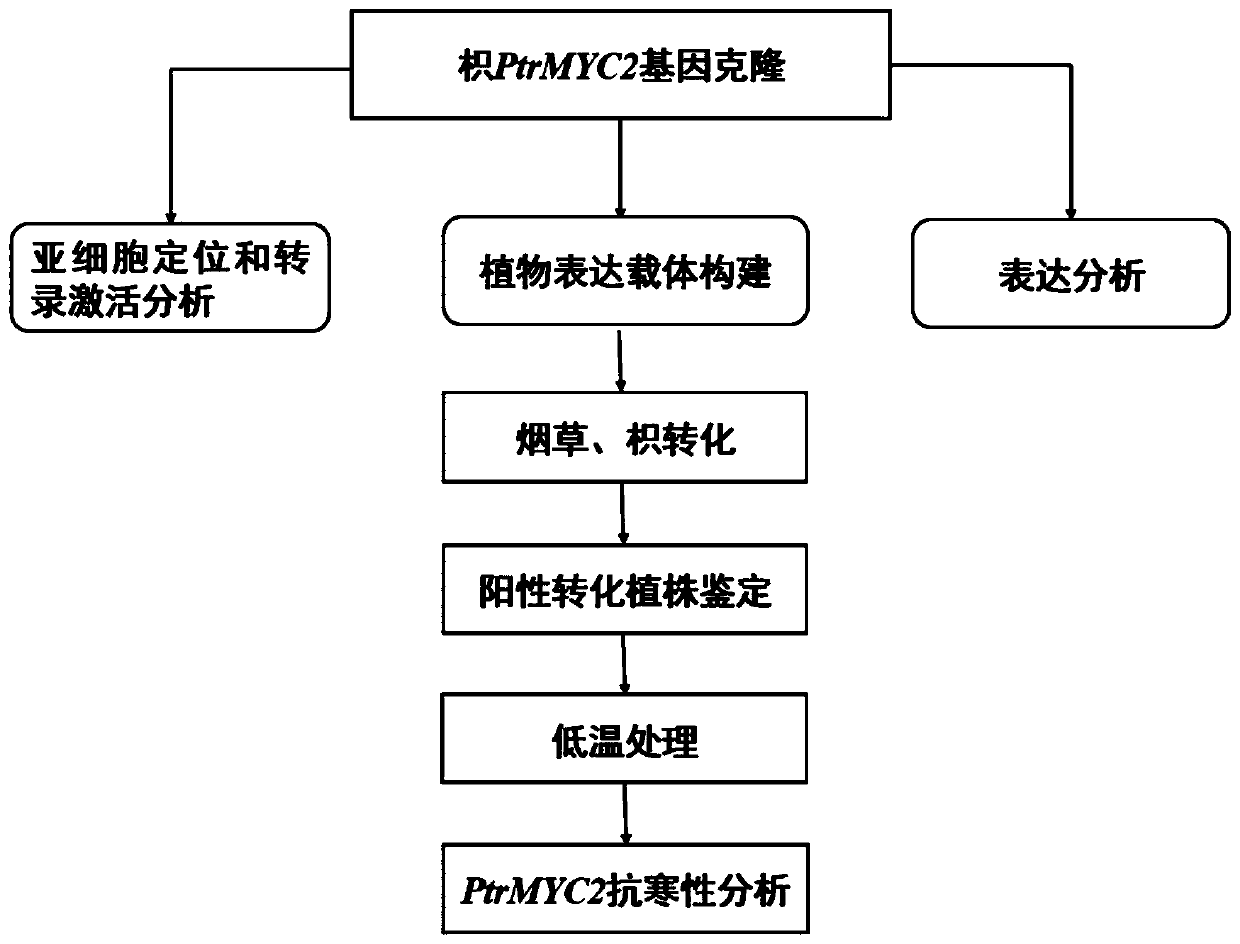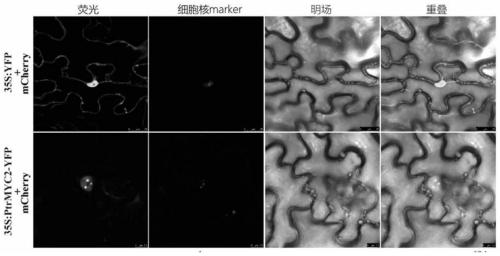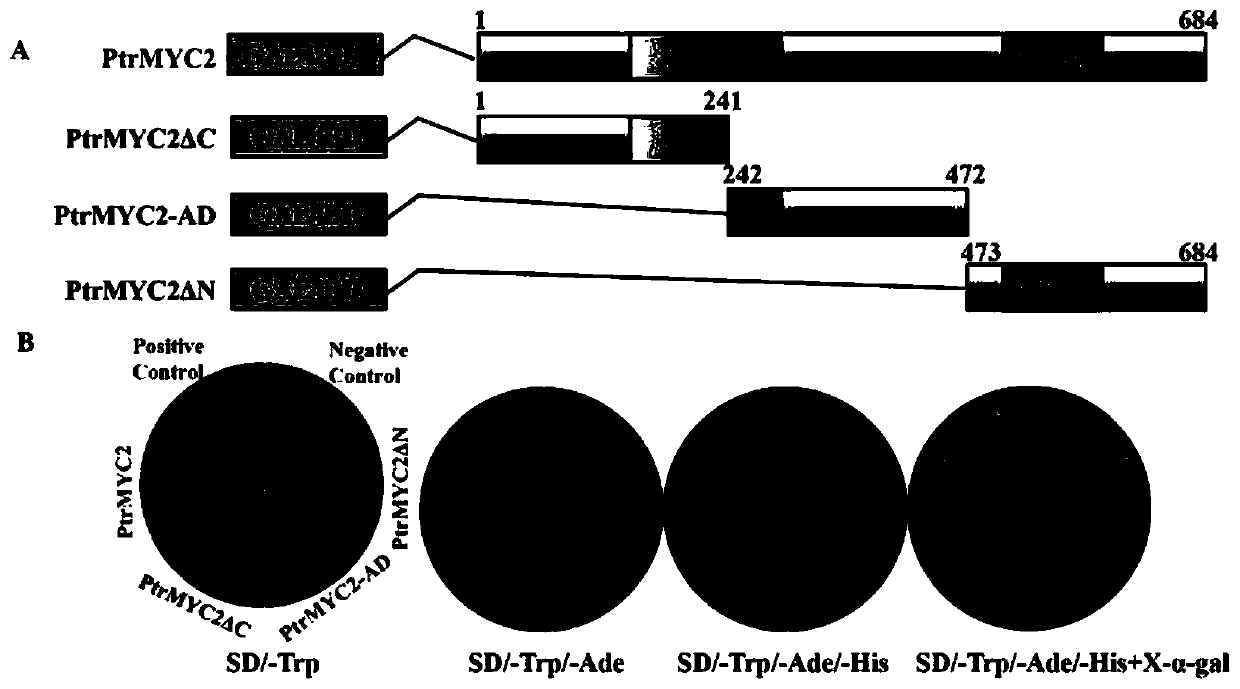Cold-resistant gene PtrMYC2 of trifoliate orange and application of cold-resistant gene PtrMYC2 in cold-resistant genetic improvement of plants
A plant and gene technology, applied in the field of plant genetic engineering, to reduce agricultural production costs and achieve the effect of environmental friendliness
- Summary
- Abstract
- Description
- Claims
- Application Information
AI Technical Summary
Problems solved by technology
Method used
Image
Examples
Embodiment 1
[0033] Cloning of full-length cDNA of PtrMYC2 gene in trifoliate orange and construction of overexpression vector pBI121
[0034]Using Hovenia trifoliate cDNA as a template, high-fidelity enzymes were used to amplify. The amplification system is shown in Table 1, and the amplification program is shown in Table 2. The primers used were pBI121-MYC2 overexpression primers: F: 5'-GAGAACACGGGGGACTCTAGAATGACGGACTACCGGTTACCTTC-3' and R: 5'-ATAAGGGACTGACCACCCGGGTTATTGGGTATCTCCAACTTTGGC-3'.
[0035] Table 1 Gene amplification system
[0036]
[0037] Table 2 Gene amplification PCR program
[0038]
[0039]
[0040] AxyPrep-96 DNA Gel Recovery Kit (Axygene, USA) was used to purify and recover the amplified product. Using DNA seamless cloning technology, the purified product was connected to the linearized overexpression vector pBI121, and then the ligated product was transformed into DH5α Competent cells were plated, shaken, and then positively identified. After the positive...
Embodiment 2
[0047] Genetic Transformation and Positive Identification of Tobacco
[0048] 1) Strain preparation: Take out the preserved Agrobacterium transformed into the pBI121-PtrMYC2 vector from -80°C, absorb a small amount of Agrobacterium liquid with a pipette tip, and place it in MS liquid medium without antibiotics, at 28°C, 200r / Min culture until the OD600 value reaches 0.6-0.8 for infection;
[0049] 2) Explant preparation: select the sterile tobacco with good growth, take the largest 2-3 leaves, remove the main vein and leaf edge, cut into 0.5cm 2 Put the left and right size cubes into a sterile triangular flask with a small amount of MS liquid medium for infection;
[0050] 3) Infection and co-cultivation: Pour the bacterial solution cultivated in the first step into the Erlenmeyer flask containing the explants, infect for 10 minutes, and shake gently during the infecting process. After infestation, blot dry the bacterium liquid that the explant carries with sterilized filte...
Embodiment 3
[0066] Analysis of cold resistance of PtrMYC2
[0067] Potted transgenic tobacco and wild-type tobacco (WT) at 30d seedling age were used for identification of low temperature resistance. Before low temperature treatment, there was no obvious phenotypic difference between tobacco overexpressing PtrMYC2 gene and wild-type tobacco, but after 12 hours of treatment at -2°C, the wild-type was more severely injured than the transgenic line, and most of the leaves were water-stained In the transgenic line, only part of the tobacco was water-soaked ( Figure 5 Middle A). Survival rate was counted after recovery, transgenic plants had higher survival rate ( Figure 5 Middle B), where the #2 line was 84%, the #4 line was 89%, and the survival rate of the wild type plant was only 8%. Conductivity measurement found that the relative conductivity of wild-type tobacco was higher after low temperature treatment ( Figure 5 Middle C), indicating that more severe cell membrane damage occur...
PUM
| Property | Measurement | Unit |
|---|---|---|
| molecular weight | aaaaa | aaaaa |
Abstract
Description
Claims
Application Information
 Login to View More
Login to View More - R&D
- Intellectual Property
- Life Sciences
- Materials
- Tech Scout
- Unparalleled Data Quality
- Higher Quality Content
- 60% Fewer Hallucinations
Browse by: Latest US Patents, China's latest patents, Technical Efficacy Thesaurus, Application Domain, Technology Topic, Popular Technical Reports.
© 2025 PatSnap. All rights reserved.Legal|Privacy policy|Modern Slavery Act Transparency Statement|Sitemap|About US| Contact US: help@patsnap.com



